| Article ID | Journal | Published Year | Pages | File Type |
|---|---|---|---|---|
| 4354750 | Trends in Neurosciences | 2006 | 7 Pages |
Microglia, the standby cells for immune defense in the CNS, have a reputation for exacerbating the neural damage that occurs in neurodegenerative diseases. However, research over the past few years has established that microglia do not constitute a single, uniform cell population, but rather comprise a family of cells with diverse phenotypes – some that are beneficial and others that the CNS can barely tolerate and that are therefore destructive. This finding raised several questions. What instructs microglia to acquire a particular phenotype, and how do these phenotypes differ? How committed are microglia to a specific phenotype? Can destructive microglia become protective, and can protective microglia retain their beneficial phenotype even when they encounter a destructive environment? Here, we address these questions, and the background of research that elicited them.
